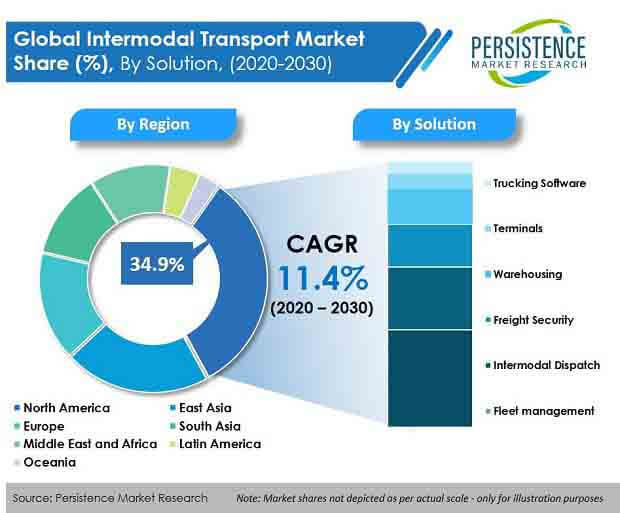Intermodal Transport Market Segmentations By Solutions- Fleet Management,Intermodal Dispatch,Freight Security,Terminals,Warehousing,Trucking Software; Mode- Rail-Road,,Road-Water,Road-Air; Vertical- Consumer And Retail,Oil And Gas,,Manufacturing Industry,Energy And Utility,Mining,Aviation,Construction,,Chemicals,Pharmaceuticals And Healthcare,Food And Beverages
Industry: Semiconductor Electronics
Published Date: September-2020
Format: PPT*, PDF, EXCEL
Delivery Timelines: Contact Sales
Number of Pages: 300
Report ID: PMRREP30517
Development of fast track systems in transportation has ensured the smooth flow of goods in case of intermodal transport. Security is one of the major concerns for shippers when it comes to transportation.
Many railroads have developed automated gate systems at intermodal ramps. AGS systems include optical character recognition, biometric identification, and high definition video imaging.
Such tools are developed to promote efficiency while maintaining safety and security. All these developments are facilitating the expansion of the intermodal transport market size.
Further, the FMCG sector prefers those transport services that bring products quickly to the market without incurring high costs. As such, this is another sector that has inclined toward the adoption of intermodal transport due to factors such as cost efficiency and eco-friendly transport mode. Increased utilization of intermodal is now a part of many organization’s supply chain strategies. Kimberly-Clark is one such well-known organization that stresses more on the utilization of intermodal freight transport in its supply chain.
Corporate Shift toward Sustainable Operations Aiding Market Growth: Companies today are more concerned about their sustainability goals. Rapid changes in consumer behavior and increasing environment-consciousness have encouraged corporates to adapt sustainable options and solutions in business operations.
This rapidly growing sustainability concept today, not only prevails in production operations but also supply chain operations. Global trade is increasing, and players in the market are focused on reducing their carbon footprints. This has compelled corporates to adopt more eco-friendly solutions in all possible business operations.
It has also facilitated growth in the adoption of intermodal transport by corporates in the market. Such rising environmental awareness is expected to open up new opportunities for the intermodal transport market over the coming years.
Adoption of Intermodal Transport by Strategic & Transactional Shippers: In the past, strategic & transactional shippers used to prefer traditional transport modes due to higher reliability.
But, due to less capacity and higher truckload prices, many shippers have now shifted toward the adoption of intermodal transport services. Such a shift has facilitated the growth of the intermodal transport market space.
Strategic shippers that have been looking to elongate their cargo transits have found a great deal of success in intermodal freight transport.

North America dominates the intermodal transport market share in terms of presence, followed by the Asia, due to improvements in intermodal shipment visibility and increased demand for intermodal transport from the automotive industry. However, the market in Asia, especially East Asia will grow at the highest rate through 2030.
The intermodal transport market is anticipated to be highly fragmented, where a large number of local players are actively operating in the global market space. Players are seeking opportunities and focusing consistently on digital platforms.
Further, players in the intermodal transport market are focusing on strengthening their market footprints across the world and providing innovative solutions to customers, so as to have a competitive advantage in this industry.
The world has been crippled by the COVID-19 outbreak, with most countries and sectors facing hardships. Travel and trade were the first to be suspended in order to curb the spread of the virus.
As such, the growth of the global intermodal transport market was badly hit. As countries ease restrictions on lockdowns, travel, and trade, intermodal cargo will gain pace, and the market is expected to get back to its original growth trajectory and surge ahead.
A brief overview of the changing landscape of the intermodal transport market has led our analysts to conclude that, the market is significantly gaining popularity in developing regions. The market will register significant expansion and growth opportunities for players over the following years across East Asia and South Asia. However, the COVID-19 pandemic outbreak has resulted in disruptions in operations (production and supply chain). Regional governments are undertaking initiatives and development actions in order to promote sustainability in the transport sector. Rising environmental consciousness has encouraged the adoption of intermodal freight transport services across the world.
PMR’s research study on the global intermodal transport market offers a detailed market taxonomy, wherein, key segments have been discussed in detail. The intermodal transport market is segmented on the basis of solution, vertical, service, type of mode, mode of ownership, and region. Every segment is analyzed in detail, and data pertaining to the growth of each segment has been included in the study.
| Attribute | Details |
|---|---|
|
Solution |
|
|
Vertical |
|
|
Service |
|
|
Type of Mode |
|
|
Mode of Ownership |
|
|
Region |
|
The intermodal transport market research report includes a competitive landscape that provides a dashboard view of the key competitors operating in the market. Some of the market players included in this section are Deutsche Post DHL Group, DB Schenker, FedEx Corporation, DSV Panalpina, Yusen Logistics Co, Ltd., Kuehne + Nagel, XPO Logistics, Inc., Evans Delivery Company, Inc., Hub Group, Swift Transportation Company, GE Transportation, HighJump Software, TMW Systems, Trinium Trucking Systems, and others.
The research study on the intermodal transport market offers inclusive insights about the growth of the market in the most comprehensive manner. Key insights offered in the intermodal transport market report answer some of the most salient questions that assist stakeholders in gauging all the emerging possibilities.
To know more about delivery timeline for this report Contact Sales
